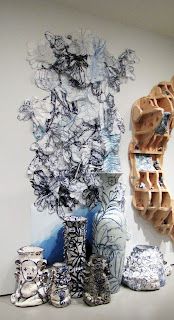Considering how much I expected to visit Boston when we were planning our move to New Hampshire, we have only "gone to town" a few times. We've been thruough town almost monthly to visit our beautiful granddaughter... but not so often to sample the cultural offerings. So I made sure I had comfortable shoes and fresh batteries when we went to the Museum of Fine Arts last week.

A small Henry Moor caught my eye: Seated figure against a curved wall. Loved the textures and kind of awkward pose.
I thought Miro's "Nuages et Oiseaux" (Clouds and birds) was a sheep at first!
The Blue and White Exhibition had been highly recommended to us by my daughter, and indeed was more thoughtprovoking and interesting than I expected. It was not merely a mish mash of historical pieces in blue and white, but included more contemporary uses of blue and white to both emphasize and contradict tradition. I might have to do a series of "just blue and white" paintings in response.
Artists in Holland combined traditional windmill shapes and blue/white colors with other traditions (as with this Middle Eastern Calligraphy) to incorporate the impact of immigrant groups.
This contemporary convolusion by a Japanese artist demonstrated amazing technical skills while appearing organic.
Another contemporary installation used a bit of everything: big floor vases, fiber, and undulated wood "shelves" with all sorts of ceramic objects and figures. It was overwhelming to look at in a "reasonable" amount of time. I can't guess at how long it took to construct!
The piece below by Annabeth Rosen who lives in the same town as my college roommate, was titled "The Wave." It was made with ceramic pieces and held together with baling wire. I've only ever thought of baling wire as a metaphorical entity. Not something you could actually USE!
Thse jars were about 4 feet tall. The women's figures, in red, were painted to look like electronic circuitry, and the explanation referred to the value of "the motherboard." I like puns... whether visual OR verbal.
The stenciling and high contrast between "white" and cobalt was very appealing on such simple shapes. They reminded me of mid-century Scandinavian pieces my mother had.
How does one neatly cut holes in a plate or bowl? The re-use/recycle of a number of pieces was breathtakingly creative.

Here is a stack of carved plates and bowls, reconstructed to make a more dimentional landscape scene.
The shadows on the teacup paintings were IN the images, not an artifact of my dubious photograph. I liked the series.
In this elaborate piece, I thought the shadows cast by the texturing was the most startling. I don't know if the whorls and bumps were carved, pulled or cast. Shiny glaze over varied texture was interesting. I might have to try to draw this.There was an "old style" wood surfboard which had been covered with a THICK layer of transparent resin into which blue, white and black images had been laid. There was depth to the images even without the black shading.
Sort of an Apple apple.
Would you make art about happy memories or disastrous ones? I can think of other examples of both kinds. But rarely is the art relating to "disasters" as "pretty" as these Delftware grenades!

We wandered around the rest of the museum. For some reason this chandeliere was blinking on and off. I was SURE I had gotten it while on. So much for certainty!
There was one small gallery of "craft" objects. This huge glass basket by Brett Young of Cleveland was , made from flame-worked pyrex was beautifully illuminated. The artist was apparently inspired by tangled heaps of rebar at a construction site.
Philip Moulthrop, in the middle of three generations of Georgia wood artisans, combined slices of wood and dyed epoxy resin to make a block which he could "turn" into this bowl form. The polish and shine made me want to touch it.
Wouldn't you know that this glass vase was by the ubiquitous Dale Chihuly. Unlike his later organic flames and flowers, this "Navajo Blanket" vase is from the mid 1970's.
Another artist made a piece about waves. John Cedarquist of San Clemente, CA, made "How to Contain Five Waves" with nods to Hokosai and the Buddhist book popular in the 1960's called How to Wrap Five Eggs. My uncle had that book on his coffee table when I was a teenager..
This "Construction #8" is by Nancy Crow. The museum information gives her credit for being a founder of the contemporary art quilting movement. GO Nancy!
Jeweled Wall is crocheted and beaded by Elizabeth Tuttle. The piece is aproximately 5 x 7 inches and mind boggling.
Linda Behar, from Cambridge, Massachusetts definitely captured the essence of "Salt Marsh I" using hand and machine embroidery over acrylic, based on her own photographs.
This 19th century bronze is supposed to be Dante and Virgil. Looks somewhat homoerotic to me... unless it was really supposed to be Dante and BEATRICE! What do you think?
There was a newly opened display of Rembrandt paintings
Talk about realism!

Something about this work (monumental in scale) made me laugh. Orpheus Charming the Animals reminded me of earlier Netherlandish paintings in which there was lots of sub-text and symbolism. What peculiar animals Aelbert Cuyp chose! A pangolin? Where would an artist have seen such a variety. (But note the common kitty and dogs.)

Sparkly stuff is always a big hit!
Quite a sewing box, don't you think?
And then just around the corner were ancient Mesopotamian artifacts.
Although these cattlemen were probably created to go into a burial chamber, it reminded me of a child's toy. These are at least 1000 years BCE.
Then we had a high priced lunch and came home to digest all that we had seen.











































No comments:
Post a Comment